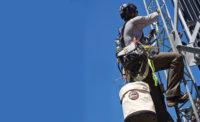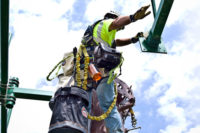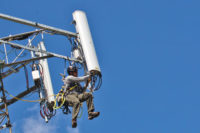In its simplest form, an object at any height isn’t the issue—it’s controlling that object so it doesn’t add to the risks already apparent— which has proven to be a pretty large issue on jobsites throughout the world. Aside from inconvenience and productivity losses of dropping an object at height and having to retrieve it, in 2013, “struck by falling object” was responsible for the loss of 245 lives in the workplace, according to the U.S. Department of Labor, Bureau of Labor Statistics. Surprisingly, this often-overlooked hazard claimed over 40 percent as many occupational deaths as actually falling from an elevated surface (595 feet), and does not include non-fatal injuries.
Quit shaming slippery fingers
With the ever-present force of gravity, unsecured things like hand tools, nuts and bolts, and even personal protective items like hardhats will become missiles when dropped from 50 stories. Slippery fingers aren’t the only problem; any of these items can be accidently kicked, dropped, blown or even fall out of a bucket from elevated work locations, such as ladders, lifts, scaffolding or platforms.
Most employers understand fall protection for workers. These programs include: job safety or hazard analyses (JSA or JHA), training and awareness, restriction of elevated work to qualified workers, use of harnesses and lifelines or tethers, and more. Fewer employers understand that many of these same controls are needed for parts, tools, and equipment as well.
Laying the groundwork
Recognition of this hazard has led companies in certain industries like utilities and telecommunications to form working groups to address the issue of dropped objects, develop prevention strategies and share best practices. Almost 20 years later, DROPS (Dropped Objects Prevention Scheme) is an example of a global organization with members in the oil & gas industry.
Safety and equipment vendors have also responded with new solutions for tethering tools and equipment and for containing loose parts that need to be transported to elevated workplaces. These types of products help employers control these hazards and comply with regulatory requirements for controlling loose or falling objects.
Know your zone
Many employers have opted for a third-party organization or trusted manufacturer to evaluate their specific jobsite for objects at heights risks. A comprehensive program like this will start with a survey of all elevated work areas. Similar in some ways to surveys associated with confined spaces, fall protection, or certain process hazards, the DROPS Best Practice Guidance classifies work zones based on potential risk to workers below:
• Green Zone: “where the layout and activities of the area present little likelihood of personnel being exposed to potential dropped objects under normal circumstances”
• Yellow Zone: “where the layout and activities of the area do present some risk of personnel being exposed to potential dropped objects under normal circumstances”
• Red Zone: “where the layout and activities of the area present significant risk of personnel being exposed to potential dropped objects under normal circumstances”
A site survey should also include an inventory of all tools, parts, and equipment used above work zones, whether done on a regular basis at a fixed location, such as at a refinery or processing plant, or done on a temporary basis, such as when erecting a communications tower or wind generator or when performing repairs on a bridge, scaffolding or a crane.
This intentional approach of specifying or controlling what is allowed at elevated work locations can have other benefits. For example, pre-assembling of parts or components on the ground can reduce the number of items that need to be tracked at elevation, reduce the number of tools that need to be carried to heights, eliminate carrying of waste or unnecessary packaging, as well as reduce the amount of time spent at heights.
The Best Practice Guidelines also recommend a review of all past incidents, including near miss events, where objects have been dropped, to identify causal and contributing factors as well as needed controls.
Connect the right way
An increasing variety of tool and object tethering solutions for working at heights are available from vendors including lanyards, tethers, tool connectors, closed pouches and re-closeable containers that prevent loose parts from flying if kicked over on a work platform or bumped when hoisting. These types of devices must be durable enough to withstand the challenges of the particular work environment (oils, chemicals, UV exposure, saltwater, heat, etc.), and as always, allow convenient access for workers wearing appropriate gloves for the tasks involved.
One of the more challenging aspects of objects at heights planning is trying to safely connect a tool to a lanyard when the tool houses no connection point, such as a hammer. Employers must find and utilize tool connectors that create an attachment point but make sure it does not interfere with the tools’ function or integrity.
These connectors should be thought of as a system, including anchor points to the worker, harness and railing. Each component of the system must be able to withstand anticipated shock loads and be regularly inspected. Temporary attachments should be secure to prevent unintended release and tether lengths should be long enough to perform required tasks without creating entanglement, snagging or trip hazards. In some situations, coiled, stretchable, or self-retracting lanyards might be preferred options.
A well-rounded program
As with a fall protection program for workers, a fall protection program for objects will include layered and overlapping controls. Guardrails and toe boards are basic elements for elevated work platforms but must be kept clear of debris and clutter, which could get kicked or blown over. In some situations, netting or other passive engineering controls may also be used. Typically designed to restrain or catch workers, each of these should be evaluated for their ability to prevent tools, parts and debris from falling onto areas below. Active engineering controls should also be used in the form of chin straps, lanyards and other retention devices should always be used to keep tools and equipment from falling.
Training for workers above and below along with signage and access control are important administrative controls, especially with higher hazard “yellow” and “red” classified zones. Work practices that eliminate placing an unsecured tool or component on a rail, ledge, step, or platform— even temporarily, need to be enforced. The use of work permits or checklists for elevated work is also another way to reinforce the importance of these measures and to help mitigate the hazard.
Bottom line
Keeping tools and gear where they should be when taken to heights requires an intentional effort, a clear understanding of tasks and operations and, occasionally, some creative solutions. Training that encompasses awareness and hands on demonstrations of the various products for tethering is key for protecting workers from something as seemingly small and benign as a dropped bolt.
Fall prevention discussions have become commonplace in the workplace, but typically employers are focused solely on preventing actual worker falls. No doubt that is extremely important. Unfortunately, the often-neglected tools and gear brought to heights can have equally devastating results.
|
References OSHA Scaffolds: 1926.451(h) – “falling object protection” Fall Protection: 1926.501(c) – “Protection from falling objects” Steel Erection:1926.759(a) – “Securing loose items aloft” General Duty Clause 29 U.S.C. § 654, 5(a)1 - “ . . .employment and a place of employment which are free from recognized hazards that are causing or are likely to cause death or serious physical harm . . .”
DROPS |




